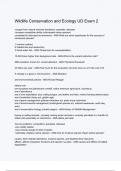Wildlife Conservation and Ecology UD Exam 2
-escape from natural enemies (predators, parasites, disease)
-increase competitive ability (outcompete native species)
-preadated to disturbed environments - ANS-What are some hypotheses for the success of
introduced species?
1/ marine systems
2/ habitat loss and destruction
3/ fresh water fish - ANS-Threat level for overexploitation
10,000 times higher than background rate - ANS-What is the current extinction rate?
26th president, known for: conservationism - ANS-Theodore Roosevelt
33 trillion per year - ANS-How much do the ecosystem services have on us? (the cost of it)
A change in a gene or chromosome. - ANS-Mutation
anti-environmental policies - ANS-Ronald Reagan
before man
pre-european era (pleistocene overkill, native american agriculture, columbus)
era of abundance
era of over exploitation (zoo, eating tongue, use leather and hide, market hunting-darkest days)
era of protection (lacey act, golden age)
era of game management (pittman-robertson act, parks more restrictive)
era of environmental management (endangered species act, national awareness, earth day,
acts)
era of conservation biology (ronald reagan) - ANS-History of Wildlife Management
buying or selling animals-- privately owning exotic animals is currently permitted in a handful of
states with essentially no restrictions - ANS-define pet trade
Can be predators, competitors, parasites, diseases
-can modify habitat
-can promote spread of other invaders
=ultimately, displace native species - ANS-How do invasive species impact native species?
causes: direct habitat alterations, invasive species, and depleted food resources
effects: affects ecosystem functions and species' success - ANS-causes and effects of habitat
degradation
, Changes in population/community structures that occur at the boundary of 2 habitats.
can be abiotic- means not derived by living organisms(air & soil temp. moisture, light);
vegetation (density, structure, invasive species, growth rates); increased predation risk;
community composition. - ANS-What is the edge effect?
decreased it by altering landscapes - ANS-What have humans done to species diversity?
diversity of genes, species and ecosystems in a region - ANS-Biodiversity
ecosystems have limited ability to adapt, removal of key habitat components and it aids
processes which destroy habitat - ANS-climate change
Estuarine (tidal and saltwater)
Palustrine (non-tidal and freshwater - ANS-what are the two types of wetlands?
evolutionary-ecological perspective, alaska national interest lands act, ronald reagan: anti
environmental policies, AWARENESS, attempts to remedy - ANS-Era of Conservation Biology
father of wildlife management. report of the committee on north american game policy -
ANS-Aldo Leopold
Federal Aid in Wildlife Restoration Act, provides funding for the selection, restoration, and
improvement of wildlife habitat, and for wildlife management research, and education. FDR
signed it - ANS-Pittman-Robertson Act
founded Sierra Club in 1892; fought unsuccessfully to prevent the damming of the Hetch Hetchy
Valley in Yosemite National Park. - ANS-John Muir
general diet and habitat requirements, high abundance, small body size, high reproductive
potential (r-strategy), good competitors, social/gregarious - ANS-What are characteristics of
invasive species?
genetic, species, ecosystem - ANS-levels of biodiversity
habitat loss and modification, and widespread introduction of a few species - ANS-What leads to
homogenization?
habitat loss, degradation and fragmentation - ANS-What is the largest threat to biodiversity and
the leading cause of animal extinctions in the world?
head of the U.S. Forest Service under Roosevelt, who believed that it was possible to make use
of natural resources while conserving them. trained abroad and COINED TERM
CONSERVATION - ANS-Gifford Pinchot




